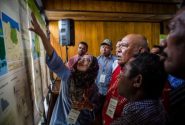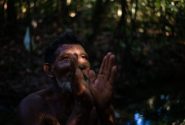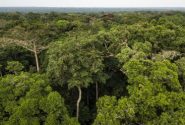
Halving of the rate of habitat loss by 2020 may be achievable under a new partnership. Angela Marie
HYDERABAD, India (12 October, 2012)_A leading research program has agreed to join forces with the United Nations Convention on Biological Diversity as part of a broader goal to cut the rate of deforestation in half by the end of the decade and to promote sustainable management of farms and forests.
“If a single tree is in your field, this is where birds will come and live. Trees in landscapes are central to sustaining terrestrial biodiversity so achieving the targets set out by the UN’s Convention of Biological Diversity would not be possible unless a multi-functional landscape management approach considering forests and trees is adopted,” said Robert Nasi, director of the CGIAR Research Program on Forests, Trees and Agroforestry who co-signed the memorandum of understanding (MoU) with the CBD Secretariat at Tree Diversity Day, held on the sidelines of this week’s 11th Conference of the Parties (COP11) in Hyderabad, India.
At the same event, the CBD Secretariat signed another MoU with the World Agroforestry Centre, signalling a renewed commitment to the sustainable use of land resources and indigenous biodiversity, as well as ‘climate smart’ agriculture.
The decision made perfect sense, Nasi said, noting that nature is holistic.
Trees provide everything from food and fuel to genetic resources used to make life-saving medicines. They restore minerals to depleted soil, oxygenate the air we breathe and helm maintain the world’s fresh water supplies.
“Virtually all visual representations of biodiversity have trees in them. Through this MoU, we are signing up to sustainable land use and biodiversity conservation, both in forests and agroforestry landscapes,” said Ravi Prabhu, ICRAF Deputy Director-General, Research.
Finding ways to protect unique ecosystems in coastal and marine areas was also listed as a priority.
Two years ago, at a conference hosted by the CBD in Nagoya, Japan, governments agreed on the so-called Aichi Biodiversity targets, which set out targets for protecting the world’s biodiversity. So far, 197 countries have signed on.
Neil Pratt, the senior environmental affairs officer of the CBD Secretariat, said the help of the CGIAR — – an international consortium of agricultural research institutes — was crucial to achieving at least five of Aichi’s 20 targets.
They include, by the year 2020:
- Halving of the rate of loss of all habitats, including forests (Target 5)
- Sustainable management of agriculture, aquaculture and forestry systems as part of efforts to significantly reduce degradation and fragmentation (Target 7)
- Ensuring the conservation of protected areas, including 17% of terrestrial and inland regions and 10% of coastal and marine areas (Target 11)
- Working to restore and safeguard ecosystems that provide essential services related to water, health, livelihood, with women, indigenous and local communities, poor and vulnerable taken into consideration (Target 14)
- Enhancing ecosystem resilience (Target 15)
Pratt said Wednesday’s agreement was similar to one signed earlier with the International Tropical Timber Organization on sustainable use of tropical timber.
Both, he said, are essential for achieving the Aichi targets, which “took 12 years to put in place and translate.”
“Now it is time to focus on implementation,” he said, adding that to do so, “it’s important for the secretariat to stimulate and support implementation.”

Left to Right: Braulio Ferreira de Souza Dias, CBD Executive Secretary; Robert Nasi, CIFOR; Ravi Prabhu, ICRAF and Pablo Eyzaguirre, Bioversity, sign an MoU as partners in the CGIAR Research Program on Forests, Trees and Agroforestry and the SCBD (2012-2016). Kara Brown.
Nasi agreed, and said the MOU to jointly study the diversity of tree species, will help CGIAR as well.
“The CGIAR is trying to become more outcome orientated,” he said.
“If we can have a convergence of development outcomes between the CBD and our research program, it will make it easier to measure progress and directly link research outcomes to the Aichi targets.”
The Center for International Forestry Research leads the Forest, Trees and Agroforestry research program in partnership with Bioversity International, the International Center for Tropical Agriculture and the World Agroforestry Centre.
For photos from Tree Diversity Day, click here.
We want you to share Forests News content, which is licensed under Creative Commons Attribution-NonCommercial-ShareAlike 4.0 International (CC BY-NC-SA 4.0). This means you are free to redistribute our material for non-commercial purposes. All we ask is that you give Forests News appropriate credit and link to the original Forests News content, indicate if changes were made, and distribute your contributions under the same Creative Commons license. You must notify Forests News if you repost, reprint or reuse our materials by contacting forestsnews@cifor-icraf.org.











